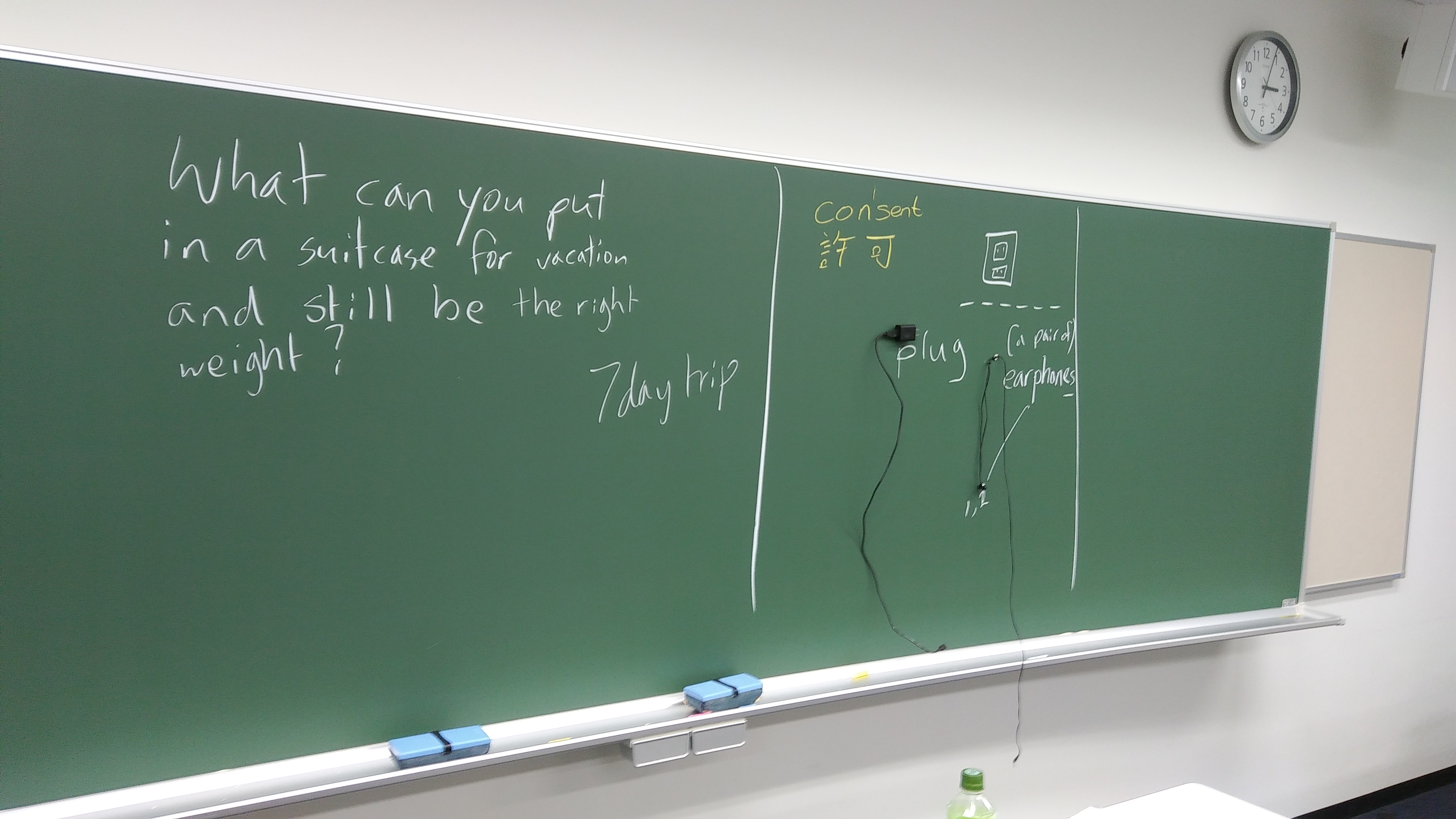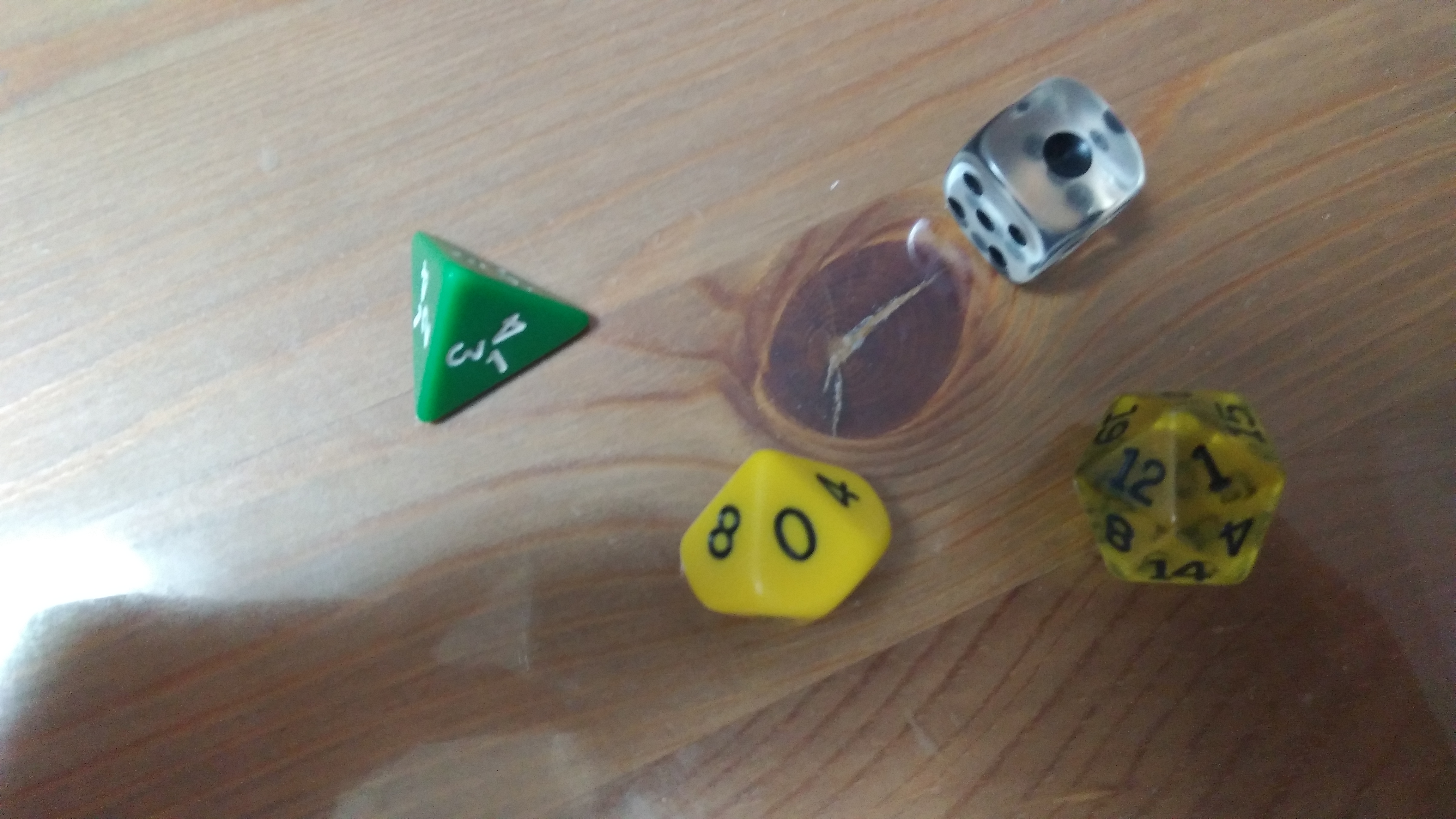Well, today is something a bit different. I thought I’d show you a picture of my whiteboard near the start of class.
The students were answering the question on the main part of the board. We came upon one of the trickiest sets of loanword-versus-usage problems. Also there were a couple of issues with “(a pair of) THINGs” that is really a pluralised single item.

Luckily I had some really with me. I would have loved to pull the socket of the wall, too.
I almost always have Print Tack (or くつきむし [kutsukimushi] in Japanese) with me. It’s what I use for reading/picture gallery tasks, too.
Do you use the whiteboard or blackboard for anything a bit different?
Month: May 2017
Here Be (Dungeons and) Dragons: 7
Back to the Campaign

I’m not satisfied with the RPG courses at the moment but I can see what it is that I want. I want to be able to just put everything in place like I have five years experience of RPGs rather than feeling my way blind.
So what would I do with all my unearned experience? Well, I think I would like to delegate some of the Dungeon Master responsibilities to the students. Learner Autonomy is a good thing. The only problem is only about a handful are capable of putting together a scenario and scoring. Because Japan is a groupist culture, this means I would run the risk of putting noses out of joint.
Another thing that I hadn’t thought through properly is item functions. The class at UOT has won some items but LCST has had no items in the game, yet. I was considering using these items to fiddle the game and let conscientious learners get high scores but in all honesty all the students are conscientious enough to keep me happy. Still, a few things could make it more interesting.
So what I am going to do is add items in the next few stages and have clear benefits to them.
I will ask of anyone wants Dungeon Master homework. I might even make a tutorial video about using Google Slides, too.
Read Here be (Dungeons and) Dragons previous ‘chapters’: 1, 2, 3, 4, 5, 6
Here be (Dungeons and) Dragons 6: Interlude

Interlude, or stopping the game and assessing.
Who’s assessing?
Well, funny you should say that. At Ladies College of Suburban Tokyo (LCST) I went around two classes of twenty odd, checking portfolios in progress while the students planned repeat tasks. I assigned them to re-record the most difficult task of the last 4 weeks, listen to the new one, listen to the previous one and judge which is better and how or why? Also, it gives a chance to see what still needs to be done. These students are a bit more savvy with academic skills as well as IT, and I don’t have access to a CALL room so I didn’t run a lesson on PowerPoint and OneNote or Google Apps to collate work.
The students’ work outside class has been a good mix of practice with elllo.org and dreamreader.net but also a lot of indiscriminate grammar drills from high-school textbooks, despite my urge to study grammar from graded readers, listening or something with a lot of context or cotext.
At University Outside Tokyo (UOT), I had more students than usual after a prompt of “come to class or face failing again”. Some students were savvy, others not so. I showed how to use PowerPoint to gather pictures and annotate them for vocabulary and how to drag and drop multimedia files. I was hoping this would take about 50 minutes but young people in Japan, while mobile literate are sometimes not very computer literate. They’ll redo tasks at the start of the next lesson.
At least I know now what the demands are, how much time it takes me to get around everyone to give feedback and the students know to make better use of grammar drills and such.
Read Here be (Dungeons and) Dragons previous ‘chapters’: 1, 2, 3, 4, 5
Reading Gallery Lesson – quick prep activity

Image from Night of the Living Dead, George A. Romero 1968 – no copyright.
This is an activity similar to one I did before from this TBLT Task Ideas Linoit Board where you can get students to choose one thing from a set of limited options. For this lesson I chose eight films from the top 50 list on imdb.com and copied and pasted the story synopsis into text files. You could get your students to choose. I didn’t because I was a bit short of time for various reasons. I then set my students in groups of four to choose one film to watch together.
I ran the text files through TagAnt to tag them for parts of speech in AntConc corpus concordancer. You’ll want the TagAnt tag list handy to check grammar in AntConc.
Open the tagged files in AntConc. Check the clusters, N-grams and word frequencies (including tags). In my mini corpus I found that the most key grammar was present simple passives and also there were a lot more proper nouns than expected. I kept this in mind for Focus on Form and actually did need to focus on form on passives.
Print the untagged text files after changing fonts and tidying them in your favourite word processor. Print, cut, and pin/stick to the wall.
I had my students in groups of four take rotating turns to read for: new vocabulary, storyline, setting, and characters. For odd numbers – groups of five with two assigned to new vocab or groups of three with setting and characters both assigned to one student. Dictionary checking halfway through the task and again at the end. They then read and choose which film to watch (or which trailer to watch as homework and write about in their learning journals).
A lot of my students chose a film because ‘it was the only film we understood and liked’, which is fine, in my opinion. I told them that I don’t choose to watch films that I don’t understand the story synopses of. I also had borne in mind the number of proper nouns counted in the corpus so remembered to tell students who looked a bit stuck that if the difficult word was capitalised in the the middle of a sentence it was probably a place or a person.
It wasn’t bad but it wasn’t as good as I expected. Even with short texts. the lesson was a bit hard. Some pictures of the films probably would have been useful. Anyway, you live and learn, don’t you?
Here be (Dungeons and) Dragons 5
The crap lesson
This week at LCST the task was to ask which metro station a sightseeing spot is near. Unfortunately the lesson wasn’t very good. The first steps of the task were very poor. It wasn’t helped by assuming students would be able to just ask where a foreign place is. The complexity of the task needed to be thought about first.
I suppose this needs to be key in task design. Perhaps a task design process should be considered. A preliminary idea is:
Task Design Process
-
Idea
-
What language functions are necessary?
-
What different skills are needed?
-
What is likely to occur?
-
What can be done to scaffold to enable best-case scenarios?
-
Review
-
Check what could go wrong at each step.
So, anyway, after a focus on form on questions and longer answers, I’d say the task was finally done well, but I’ll check over everything so far in next week’s review lesson.
Read Here be (Dungeons and) Dragons previous ‘chapters’: 1, 2, 3, 4
Read the future chapters 6